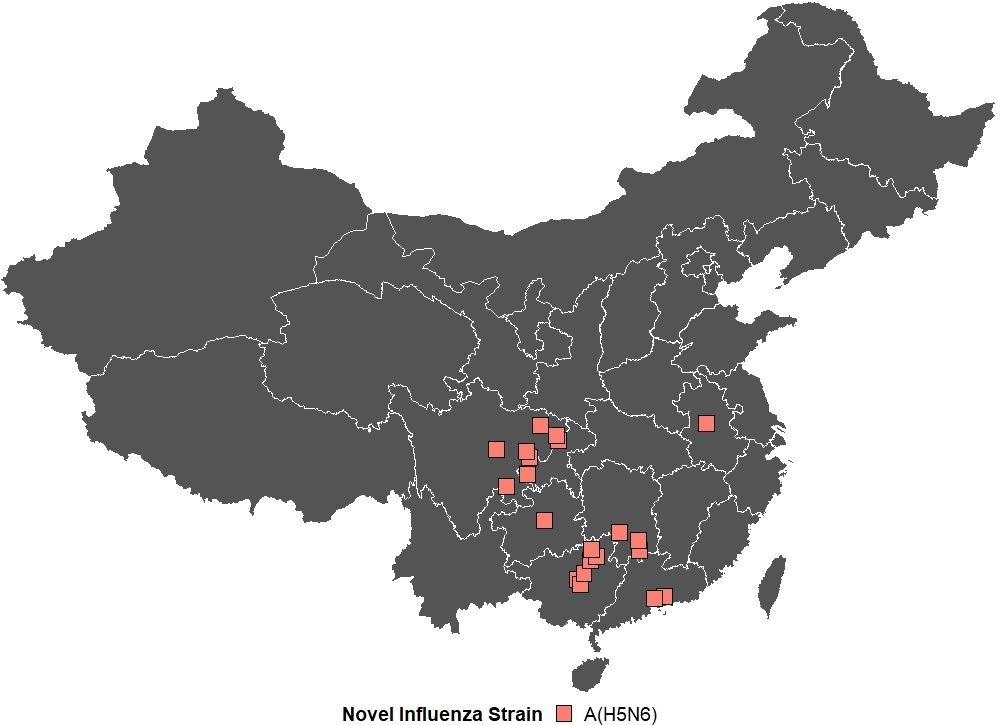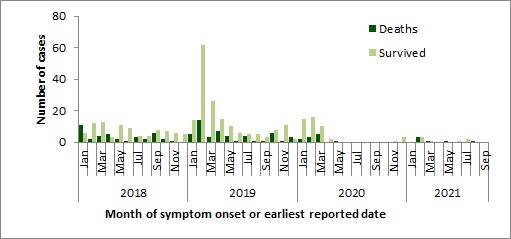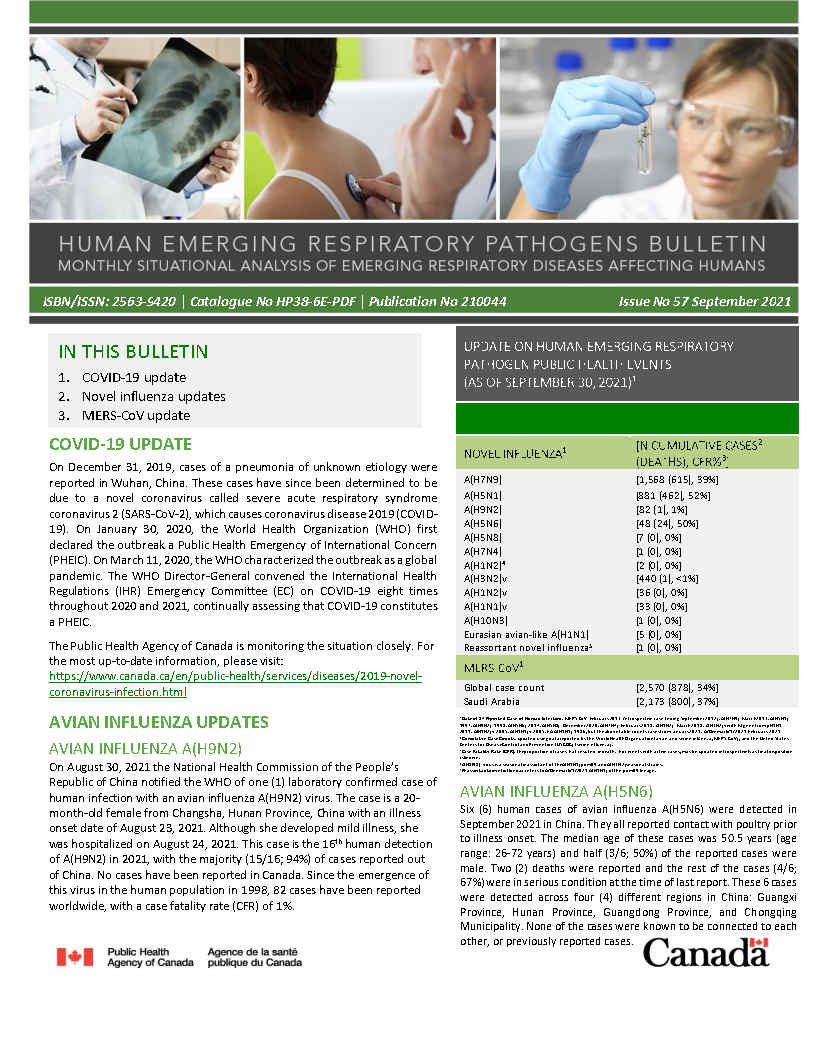Human emerging respiratory pathogens bulletin: Issue 57, September 2021
Download in PDF format
(1.15 MB, 3 pages)
Organization: Public Health Agency of Canada
Date published: 2021-10-12
Monthly situational analysis of emerging respiratory diseases affecting humans (data to September 30, 2021)
In this bulletin
- COVID-2019 update
- Avian influenza updates
- Swine influenza updates
- Middle East respiratory syndrome coronavirus (MERS-CoV) update
| Novel influenzaTable 1 Footnote 1 | Cumulative Case CountTable 1 Footnote 2 | Deaths | Case Fatality Rate %Table 1 Footnote 3 |
|---|---|---|---|
| A(H7N9) | 1,568 | 615 | 39% |
| A(H5N1) | 881 | 462 | 52% |
| A(H9N2) | 82 | 1 | 1% |
| A(H5N6) | 42 | 24 | 50% |
| A(H5N8) | 7 | 0 | 0% |
| A(H7N4) | 1 | 0 | 0% |
| A(H1N2)Table 1 Footnote 4 | 2 | 0 | 0% |
| A(H3N2)v | 440 | 1 | <1% |
| A(H1N2)v | 36 | 0 | 0% |
| A(H1N1)v | 33 | 0 | 0% |
| A(H10N3) | 1 | 0 | 0% |
| Eurasian avian-like A(H1N1) | 5 | 0 | 0% |
| Reassortant novel influenzaTable 1 Footnote 5 | 1 | 0 | 0% |
|
|||
| MERS-CoVTable 2 Footnote 1 | Cumulative Case CountTable 2 Footnote 2 | Deaths | Case Fatality Rate %Table 2 Footnote 3 |
|---|---|---|---|
| Global Case Count | 2,570 | 878 | 34% |
| Saudi Arabia | 2,173 | 800 | 37% |
|
|||
COVID-19 update
On December 31, 2019, cases of a pneumonia of unknown etiology were reported in Wuhan, China. These cases have since been determined to be due to a novel coronavirus called severe acute respiratory syndrome coronavirus 2 (SARS-CoV-2), which causes coronavirus disease 2019 (COVID-19). On January 30, 2020, the World Health Organization (WHO) first declared the outbreak a Public Health Emergency of International Concern (PHEIC). On March 11, 2020, the WHO characterized the outbreak as a global pandemic. The WHO Director-General convened the International Health Regulations (IHR) Emergency Committee (EC) on COVID-19 eight times throughout 2020 and 2021, continually assessing that COVID-19 constitutes a PHEIC.
The Public Health Agency of Canada is monitoring the situation closely.
Avian influenza updates
Avian influenza A(H9N2)
On August 30, 2021 the National Health Commission of the People's Republic of China notified the WHO of one (1) laboratory confirmed case of human infection with an avian influenza A(H9N2) virus. The case is a 20-month-old female from Changsha, Hunan Province, China with an illness onset date of August 23, 2021. Although she developed mild illness, she was hospitalized on August 24, 2021. This case is the 16th human detection of A(H9N2) in 2021, with the majority (15/16; 94%) of cases reported out of China. No cases have been reported in Canada. Since the emergence of this virus in the human population in 1998, 82 cases have been reported worldwide, with a case fatality rate (CFR) of 1%.
Avian influenza A(H5N6)
Six (6) human cases of avian influenza A(H5N6) were detected in September 2021 in China. They all reported contact with poultry prior to illness onset. The median age of these cases was 50.5 years (age range: 26-72 years) and half (3/6; 50%) of the reported cases were male. Two (2) deaths were reported and the rest of the cases (4/6; 67%) were in serious condition at the time of last report. These 6 cases were detected across four (4) different regions in China: Guangxi Province, Hunan Province, Guangdong Province, and Chongqing Municipality. None of the cases were known to be connected to each other, or previously reported cases.
Globally, 48 human cases of A(H5N6) have been reported since 2014 (24 of them fatal), with 47 of these cases reported from China. Twenty-two (22) cases were reported in 2021; 21 from China (Figure 2) and one (1) from Lao PDR. No A(H5N6) detections have been reported in Canadian residents since reporting began in 2014.
Swine influenza updates
Swine origin influenza A(H1N2)v
In September 2021, three (3) new human cases of A(H1N2)v were detected around the world, two (2) in the United States (US) and one (1) in France. The first case from the US was from Iowa. The case, <18 years of age, was not hospitalized and had fully recovered at the time of report. No human-to-human transmission was identified in association with this case. Swine contact was reported, although it is unclear whether it was direct contact or contact through household members who work with swine. The second case from the US was from Ohio. The case, <18 years of age, was not hospitalized, and also had fully recovered at the time of report. Neither the case nor their household contacts reported any contact with swine prior to illness onset. No ongoing human-to-human transmission was identified. The third case was reported from the Brittany region in France. He was in his 60s and reported contact with swine a week prior to symptom onset. He was hospitalized, treated, and discharged in late August 2021. No close contacts or co-exposed individuals developed any symptoms.
Two A(H1N2)v detections have been reported in Canadian residents since reporting began in 2005, with the latest case reported in April 2021. A total of 36 cases have been reported globally since 2005. There have been eight (8) A(H1N2)v cases reported worldwide in 2021.
Swine origin influenza A(H3N2)v
In September 2021, the US CDC reported one (1) new human case of swine origin influenza A(H3N2)v in Iowa. The case, <18 years of age, was not hospitalized and had fully recovered at the time of report. No human-to-human transmission was identified in association with this case. Swine contact was reported, although it is unclear whether it was direct contact or contact through household members who work with swine.
Two A(H3N2)v detections have been reported in Canadian residents since reporting began in 2005, with the latest case reported inJune 2021. Globally, 440 A(H3N2)v cases have been reported since 2005, with <1% case fatality rate. There have been 4 A(H3N2)v cases reported worldwide in 2021.
Swine origin influenza A(H1N1)v
The most recent case of swine origin influenza A(H1N1)v was reported in June 2021 from the United States.
Two A(H1N1)v detections have been reported in Canadian residents since reporting began in 2005, with the latest case reported in April 2021. Globally, 33 human cases of A(H1N1)v have been reported since 2005, with no associated fatalities. There have been two (2) A(H1N1)v cases reported worldwide in 2021.

Note: Map was prepared by the Centre for Immunization and Respiratory Infectious Diseases (CIRID) using data from the latest WHO Event Information Site (EIS) postings and Weekly US Influenza Surveillance Reports (FluView). This map reflects data available through these publications as of September 30, 2021.
Figure 1 - Text equivalent
- Six A(H5N6) cases were reported in China.
- Two A(H1N2)v cases were reported in the United States of America and one A(H1N2)v case was reported in France.
- One A(H3N2)v case was reported in the United States of America.
- One A(H9N2) case was reported in China.

Note: Map was prepared by the Centre for Immunization and Respiratory Infectious Diseases (CIRID) using data from the WHO EIS postings and the Hong Kong Centre for Health Protection (CHP) press releases. This map reflects data available through these publications as of September 30, 2021.
Figure 2 - Text equivalent
- One case was reported out of Yongchuan, Chongqing Municipality.
- One case was reported out of Guizhou Province.
- One case was reported out of Anhui Province.
- Two cases were reported out of Guangxi Zhuang Autonomous Region.
- One case was reported out of Chengdu, Sichuan Province.
- One case was reported out of Bazhong, Sichuan Province.
- One case was reported out of Kaijiang, Sichuan Province.
- Two cases were reported out of Tongnan, Chongqing Municipality.
- One case was reported out of Xuanhan, Sichuan Province.
- Three cases were reported out of Guilin, Guangxi Zhuang Autonomous Region.
- One case was reported out of Yibin, Sichuan Province.
- One case was reported out of Huizhou, Guangdong Province.
- One case was repored out of Dongguan, Guangdong Province.
- One case was reported out of Laibin, Guangxi Zhuang Autonomous Region.
- Two cases were reported out of Chenzhou, Hunan Province.
- One case was reported out of Yongzhou, Hunan Province.
Middle East respiratory syndrome coronavirus (MERS-CoV) update
No new MERS-CoV cases were reported in September 2021. In total, 13 cases of MERS-CoV have been reported globally in 2021 [six (6) of them fatal], with 12 of these cases reported from Saudi Arabia. A total of 2,570 laboratory-confirmed cases of MERS-CoV, including 878 deaths, have been reported globally since 2012 by the WHO. No cases have been reported in Canada.

Note: Graph was prepared by the Centre for Immunization and Respiratory Infectious Diseases (CIRID) using data from the WHO Disease Outbreak News and Saudi Arabia's Ministry of Health. This graph reflects data available as of September 30, 2021.
Figure 3 - Text equivalent
| Year | Month | Deaths | Survived |
|---|---|---|---|
| 2018 | Jan | 11 | 6 |
| Feb | 2 | 12 | |
| Mar | 4 | 13 | |
| Apr | 5 | 3 | |
| May | 2 | 11 | |
| June | 1 | 9 | |
| July | 3 | 4 | |
| Aug | 2 | 4 | |
| Sep | 6 | 8 | |
| Oct | 2 | 7 | |
| Nov | 1 | 6 | |
| Dec | 0 | 5 | |
| 2019 | Jan | 5 | 14 |
| Feb | 14 | 62 | |
| Mar | 3 | 26 | |
| Apr | 7 | 15 | |
| May | 4 | 10 | |
| June | 1 | 6 | |
| July | 4 | 5 | |
| Aug | 1 | 5 | |
| Sep | 1 | 3 | |
| Oct | 6 | 8 | |
| Nov | 1 | 11 | |
| Dec | 3 | 2 | |
| 2020 | Jan | 2 | 15 |
| Feb | 3 | 16 | |
| Mar | 5 | 10 | |
| Apr | 0 | 2 | |
| May | 1 | 0 | |
| June | 0 | 0 | |
| July | 0 | 0 | |
| Aug | 0 | 0 | |
| Sep | 0 | 0 | |
| Oct | 0 | 0 | |
| Nov | 0 | 1 | |
| Dec | 0 | 3 | |
| 2021 | Jan | 0 | 0 |
| Feb | 3 | 3 | |
| Mar | 1 | 1 | |
| Apr | 0 | 0 | |
| May | 1 | 0 | |
| June | 0 | 1 | |
| July | 0 | 2 | |
| Aug | 1 | 0 | |
| Sep | 0 | 0 |
